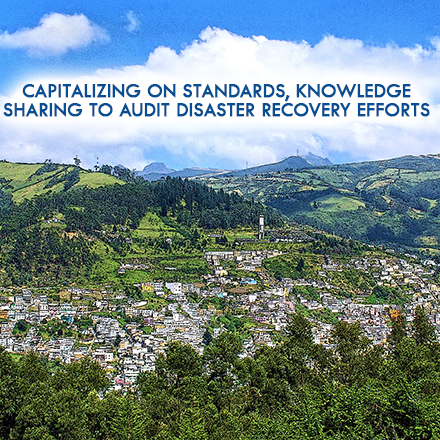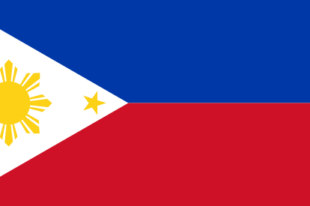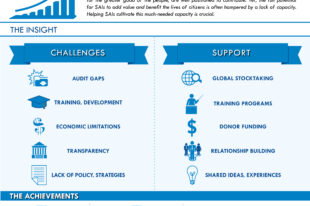Capitalizing on Standards, Knowledge Sharing to Audit Disaster Recovery Efforts

by Betty Carrion Ruiz, Auditor, Office of the Comptroller General of the Republic of Ecuador
In 2016, a 7.8 magnitude earthquake rocked the Ecuadorian coast, constituting one of the most catastrophic tragedies in the history of the country. The quake left 663 people dead, 6,274 injured, 80,000 people displaced, great damage to infrastructure and more than 2,300 aftershocks in the following months.1
Consequently, reparation measures cost approximately 3,344 USD million, challenging the response capacity of numerous public institutions, including the Office of the Comptroller General of the Republic of Ecuador—the nation’s Supreme Audit Institution (SAI).
Ecuador’s government responded to the crisis by immediately declaring a state of emergency and implementing several actions: activating contingency plans, establishing National, Provincial and Cantonal Emergency Operations Committees and creating the Committee for Reconstruction and Productive Reactivation.
The government also enacted the Organic Law of Solidarity and Citizen Co-Responsibility for the Reconstruction and Reactivation of the Affected Areas (Solidarity Law)2 and required the involvement of various public entities, including the armed forces, Integrated Security Service (ECU911), Ministry of the Interior, Ministry of Transportation and Public Works, National Police and Secretary of Risk Management.
The Solidarity Law, effective May 2016, established required contributions from citizens to help address the earthquake’s aftermath and recovery efforts—an increase in value added tax for one year; an 8-month 3.3% payment from employment wages; a less-than-one percent stipend gathered from equities exceeding one million dollars; existing real property taxation of 3.3%; and a 3% contribution from realized profits.
These funds (along with international aid) allowed for the planning, construction and reconstruction of public and private infrastructure. The monies also promoted productive reactivation by helping implement a wide array of initiatives and making it possible for SAI Ecuador (as the technical body in charge of controlling the use of public resources) to initiate audits of the entities responsible for administering the initiatives.
SAI Ecuador’s audits aimed to (1) establish accuracy, veracity and legality of the implemented emergency actions, controls and resources; (2) verify legal and regulatory compliance; (3) examine solidarity collections to ensure funds were allocated accordingly to the affected areas; and (4) determine if resources were distributed to victims in accordance with established legal procedures.
The audit results, featured in 60 reports approved and published by SAI Ecuador, showed that public entities coordinated actions to mitigate and reduce the earthquake’s impact—displacement of medical brigades; employment of public works personnel and heavy equipment for the demolition and removal of debris; and the reception, packing, transportation and delivery of humanitarian aid.
Despite positive actions evidenced, weaknesses of great social impact were also identified—using resources for other purposes not associated with the earthquake; shortcomings in the storage and delivery of food kits that prevented timely distribution; and lack of documentation to determine final beneficiaries. Resources were wasted in unnecessary acquisitions, the reception of goods outside contractual terms resulted in fines, customs clearance and delivery processes negatively impacted international humanitarian aid to victims, and there was an overall lack of documentation for monitoring and controlling administrative and financial operations, including current expense payments from Solidarity Law funds.
Additionally, numerous irregularities were discovered, such as contracts having no mandatory clauses of fines and guarantees; a lack of contingency plans for seismic events; absence of insurance policies for emergencies; and a shortage qualified and validated shelters.
SAI Ecuador’s findings resulted in the following recommended corrective actions:
- Devise system to ensure donated resources are distributed to correct destinations;
- Reinforce coordination, supervision and control actions to plan, organize and execute natural disaster prevention, rescue and remediation assistance;
- Implement and comply with donation and humanitarian aid provisions associated with proper storage and organization to ensure adequate resource arrival and conservation;
- Issue clear relief aid guidelines so donations can clear customs in the shortest possible time, avoid prolonged periods of storage and ensure timely distribution to victims; and
- Carry out training and simulations on risk management (for public and private servants, educational institutions, as well as the general community).
The International Standard for Supreme Audit Institutions (ISSAI) 55203 on “Audit of Disaster-Related Aid” states that auditors should know the entire cycle of disaster management, which, in its later phase, includes relief activities and recovery from emergency, rehabilitation and reconstruction. In addition, auditors must understand disaster events require a certain degree of flexibility. This may imply temporary non-compliance with regulations and/or the application of a special legal framework in emergency situations.
ISSAI 5520 also invites auditors to consider initiating audits at an early stage (in real time) to collect evidence in practice and perform a risk assessment that includes: delay, economy, environmental damage, financial statements risk, fraud and corruption, funds, inefficiency and inefficacy, resource and assistance distribution, undesirable recipients, unregistered aid. In Ecuador’s case, evaluating these risks allowed auditors to identify weaknesses and irregularities and propose improvement actions to optimize management of future events.
Learning from other SAIs that have dealt with similar issues is also beneficial. The National Audit Office of the People’s Republic of China (CNAO), a world leader in disaster control, has implemented strategies to avoid major failures in reconstruction, detecting obstacles, identifying shortfalls in coordinating and managing funds, and proposing timely corrections through constructive recommendations.
Natural disasters cannot be prevented, but some of the potential effects can be minimized. Looking into past events, past practices and learning from the experience of others can help auditors propose improvements related to oversight, help establish new mechanisms to address weaknesses and irregularities, and, ultimately, positively impact the lives of citizens.
References
1Instituto Nacional de Estadística y Censos (INEC, 2017), Reconstruyendo las Cifras Luego del Sismo Memorias, obrained from: http://www.ecuadorencifras.gob.ec/documentos/web-inec/Bibliotecas/Libros/Memorias%2013%20abr%202017.pdf.
2To see the law, please click here.
3ISSAI 5520, Appendix 7.
Notes
SAI Ecuador is still executing control actions related to this event. Important preliminary results are still in the approval process.





